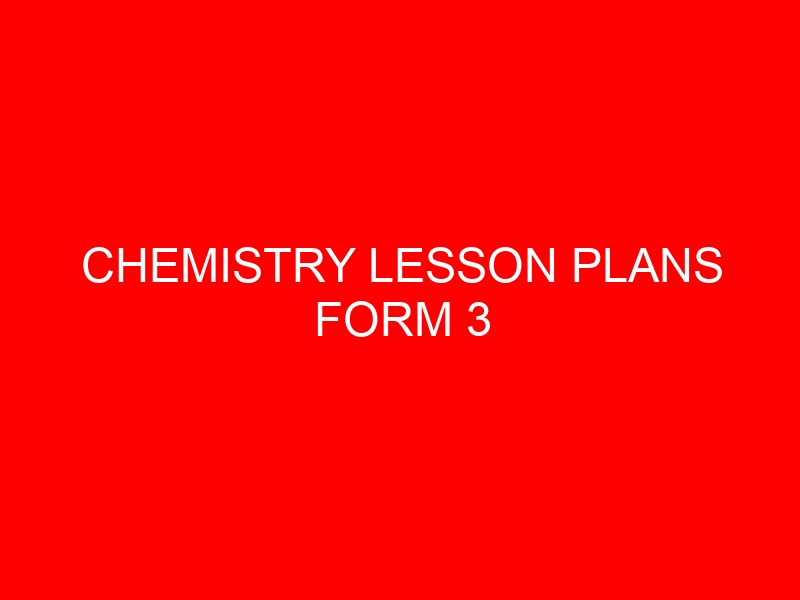FORM 3
TERM 1
SUBJECT: CHEMISTRY.
TOPIC 1: GAS LAWS.
TEACHER’S NAME: ………………………………………… TSC NO: …………….
SCHOOL/ INSTITUTION : ……………………………………………………………….
FORM: 3 TERM: 1 YEAR……………..
NUMBER OF STUDENTS……. SUBJECT: CHEMISTRY
TOPIC: GAS LAWS.
SUB-TOPIC: BOYLE’S LAW.
WEEK: …….. LESSON NUMBER: ……..
DATE: …….. TIME: ……….
OBJECTIVES: By the end of the lesson the learner should be able to;
-State Boyle’s law.
-Explain Boyle’s law using kinetic theory of matter.
-Represent Boyle’s law mathematically and graphically.
-Solve further problems involving Boyle’s law.
-Plot and interpret graphs involving pressure and volume of gases.
LESSON PRESENTATION
| TIME | CONTENT | LEARNING ACTIVITIES | RESOURCES | REFERENCE |
| 5 MINUTES | INTRODUCTION
State the Boyle’s law. |
Discussion.
Questions and answers.
|
-Chalk board/white board.
-A piece of chalk/ marker pen.
|
K.L.B. BK III
PP. 1-5
|
| 30 MINUTES | BODY DEVELOPMENT
-State Boyle’s law. -Explain Boyle’s law using kinetic theory of matter. -Represent Boyle’s law mathematically and graphically. -Solve further problems involving Boyle’s law. -Plot and interpret graphs involving pressure and volume of gases.
|
-State Boyle’s law.
-Explain Boyle’s law using kinetic theory of matter. -Represent Boyle’s law mathematically and graphically. -Solve further problems involving Boyle’s law. -Plot and interpret graphs involving pressure and volume of gases.
|
Chart
Volume-pressure relationship. Syringes. Calculators. Graph papers. |
K.L.B. BK III
PP. 1-5 Longhorn Book III PP 1 -8 |
| 5 MINUTES | CONCLUSION
Giving assignments. |
Questions and answers.
|
-Chalk board/white board.
-A piece of chalk/ marker pen.
|
K.L.B. BK III
PP. 1-5
|
SELF-EVALUATION:_______________________________________________________________________________________________________________________________________________________________________________________________________________________________________________________________________________________________________________________
TEACHER’S NAME: ………………………………………… TSC NO: …………….
SCHOOL/ INSTITUTION : ……………………………………………………………….
FORM: 3 TERM: 1 YEAR……………..
NUMBER OF STUDENTS……. SUBJECT: CHEMISTRY
TOPIC: GAS LAWS.
SUB-TOPIC: CHARLE’S LAW.
WEEK: …….. LESSON NUMBER: ……..
DATE: …….. TIME: ……….
OBJECTIVES: By the end of the lesson the learner should be able to;
State Charles’ law.
Explain Charles’ law using kinetic theory of matter.
Convert temperature in degree Celsius to Kelvin and vice-versa.
Express Charles’ law with equations.
Give a graphical representation of Charles’ law.
Solve numerical problems based on Charles’ Law.
LESSON PRESENTATION
| TIME | CONTENT | LEARNING ACTIVITIES | RESOURCES | REFERENCE |
| 5 MINUTES | INTRODUCTION
-State Charles’ law.
|
Discussion.
Questions and answers.
|
-Chalk board/white board.
-A piece of chalk/ marker pen.
|
Longhorn Book III PP 9-14
|
| 30 MINUTES | BODY DEVELOPMENT
Teacher demonstration:- To show expansion of air when heated and contraction when pressure is constant. Explain increase in volume when temperature is raised. Q/A: – relation between volume and temperature, leading to Charles’ law. Teacher explains inter-conversion of the units. Students complete a table of temperature in the two units Derive equations from volume and temperature relationship.
Exposition: – Teacher exposes a volume-temperature graph and extrapolates it to obtain the absolute temperature. The definition of absolute temperature is exposed. Worked examples. Supervised exercise.
|
Teacher demonstration:- To show expansion of air when heated and contraction when pressure is constant.
Explain increase in volume when temperature is raised. Q/A: – relation between volume and temperature, leading to Charles’ law. Teacher explains inter-conversion of the units. Students complete a table of temperature in the two units Derive equations from volume and temperature relationship.
Exposition: – Teacher exposes a volume-temperature graph and extrapolates it to obtain the absolute temperature. The definition of absolute temperature is exposed. Worked examples. Supervised exercise.
|
Calculators.
Colored water, Glass tube, Warm water, Cork and Flask. |
K.L.B.
BK III P. 6-12
Longhorn Book III PP 9-14
|
| 5 MINUTES | CONCLUSION
Giving assignment on the sub-topic. |
Questions and answers.
|
-Chalk board/white board.
-A piece of chalk/ marker pen.
|
Longhorn Book III PP 9-14
|
SELF-EVALUATION:_______________________________________________________________________________________________________________________________________________________________________________________________________________________________________________________________________________________________________________________
TEACHER’S NAME: ………………………………………… TSC NO: …………….
SCHOOL/ INSTITUTION : ……………………………………………………………….
FORM: 3 TERM: 1 YEAR……………..
NUMBER OF STUDENTS……. SUBJECT: CHEMISTRY
TOPIC: GAS LAWS.
SUB-TOPIC: COMBINED LAW.
WEEK: …….. LESSON NUMBER: ……..
DATE: …….. TIME: ……….
OBJECTIVES: By the end of the lesson the learner should be able to;
-Derive the Gas Law.
-Derive the combined gas law equation.
-Solve numerical problems using the equation.
LESSON PRESENTATION
| TIME | CONTENT | LEARNING ACTIVITIES | RESOURCES | REFERENCE |
| 5 MINUTES | INTRODUCTION
Explain and deduce a formulae for the combined gas equation. |
Discussion.
Questions and answers.
|
-Chalk board/white board.
-A piece of chalk/ marker pen.
|
K.L.B.
BK III P. 12
|
| 30 MINUTES | BODY DEVELOPMENT
Q/A: – Combining Boyle’s and Charles’ Laws. Worked examples. |
Q/A: – Combining Boyle’s and Charles’ Laws.
Worked examples. |
Calculators. | K.L.B.
BK III P. 12
Longhorn Book III PP 14-16
|
| 5 MINUTES | CONCLUSION
Oral evaluation on the sub-topic. |
Questions and answers.
|
-Chalk board/white board.
-A piece of chalk/ marker pen.
|
K.L.B.
BK III P. 12
|
SELF-EVALUATION:_______________________________________________________________________________________________________________________________________________________________________________________________________________________________________________________________________________________________________________________

